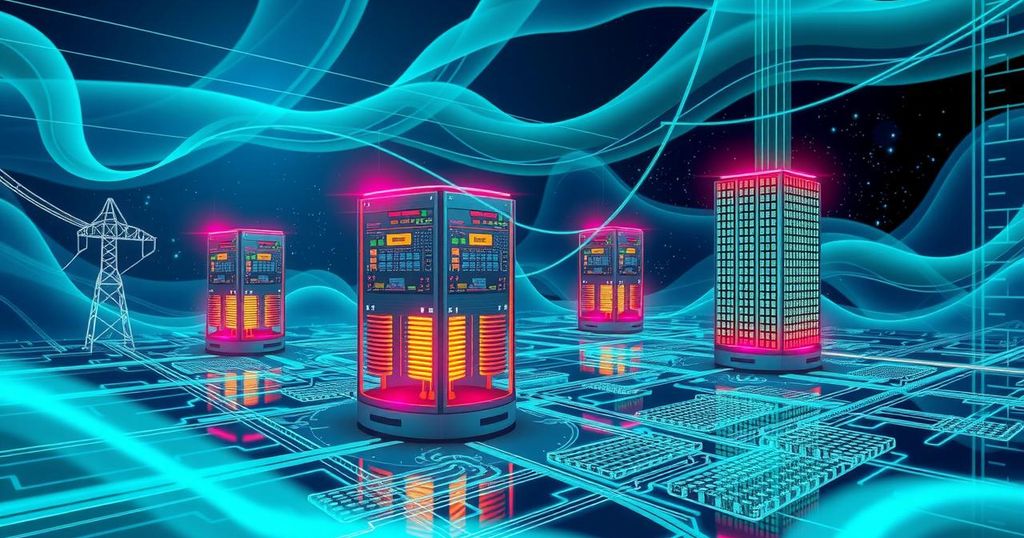AI’s Energy Surge: A Call for Cybersecurity Vigilance in the Energy Sector
The surge in AI applications is driving an enormous demand for energy, creating increased vulnerability in the energy sector to cyber threats, particularly from nations like China. With predictions indicating a doubling of AI’s energy consumption in just two years and the need for $720 billion in utility investment by 2030, experts emphasize that cybersecurity must be prioritized. Collaboration among agencies and regulatory reform are essential to secure energy resilience as AI evolves.
The rapid rise of artificial intelligence (AI) applications is demanding an unprecedented surge in energy, consequently putting the cybersecurity of the energy sector in the spotlight. As we dive deeper into this AI revolution, the importance of safeguarding our energy systems from cyber threats—particularly from nations like the People’s Republic of China (PRC)—has never been clearer. Experts from Goldman Sachs predict that within two years, the share of AI in global data center electricity consumption could double. By 2030, we might need a jaw-dropping 165 times the current energy output, which could set us back around $720 billion in necessary electric utility investments.
This spiraling demand isn’t just a trivial statistic. Surprisingly, one single interaction with AI platforms like ChatGPT consumes about ten times more electricity than a traditional Google search. When you consider a conventional server rack requiring around 7 kW, AI server racks can guzzle anywhere from 30 kW to a staggering 100 kW. To put it in perspective, by 2035, AI data centers are expected to draw the same amount of power as households in New York, California, Texas, and Florida combined.
The connection between AI dominance and energy sufficiency is becoming painfully evident. Representative Julie Fedorchak (R-ND) is on the ball when she asserts, “To be AI dominant, we must first be energy dominant.” No doubt about it; as we gear up for the AI race, ensuring a robust power supply is crucial. However, this heightened emphasis on energy also creates a wider attack surface for malicious cyber actors, particularly from nations like China, Russia, Iran, and North Korea.
The cyber threat landscape is rife with danger. Organizations linked to the PRC target critical U.S. infrastructure, and the risks are real. Various cyber-actor groups dubbed “typhoon” like Volt Typhoon, Salt Typhoon, and the rest, show just how serious these threats are. For example, while Volt Typhoon attacks vital energy systems, Salt Typhoon has focused on telecommunications. In practical terms, campaigns like these blur the lines between warfare and cyberspace, endangering the energy sector precisely when tension escalates internationally, like issues relating to Taiwan or maritime disputes in the South China Sea.
As the international race for AI supremacy deepens, the fear that adversaries could cripple our energy supply looms large. With the transition to a new administration, it’s more urgent than ever to shore up defenses around our power grids. The Cybersecurity and Infrastructure Security Agency (CISA), among other agencies, needs to collaborate closely with utility operators to neutralize threats like Volt Typhoon and bolster our reactions to cyber incidents. Attack simulations and mutual responses are some steps being taken to push back against these vulnerabilities.
Currently, initiatives like the CESER-supported Southeast Regional Cybersecurity Collaboration Center (SERC-3) strive to improve safeguards for energy firms. In partnership with Oak Ridge National Laboratory and Auburn University, this project conducts attack simulations on operational technology commonly employed by utilities. It’s an important starting point, but similar collaboration is crucial to enhancing defenses across the nation as demands rise.
As we stand at this crucial intersection—where AI potential, energy ingenuity, and cybersecurity have to mesh—there’s an eagerness from the new administration and Congress to take action. But the sluggish regulatory climate hindering both cybersecurity initiatives and infrastructure expansion could derail our ambitions. Streamlining these regulations isn’t just a nice-to-have; it’s essential for defending against cyber adversaries and ramping up energy production to meet future demands.
In short, the rise of AI is turning the spotlight on the energy sector’s vulnerability to cyber threats, particularly from nations like China. An astounding increase in energy requirements linked to AI apps emphasizes the urgent need for cybersecurity investments and cooperative efforts among agencies. Only by addressing the regulatory hurdles can we fortify our energy supply while enhancing security against the growing cyber threat landscape. Ignoring these challenges could leave us exposed just when we need resilience the most.
Original Source: www.powermag.com




Post Comment